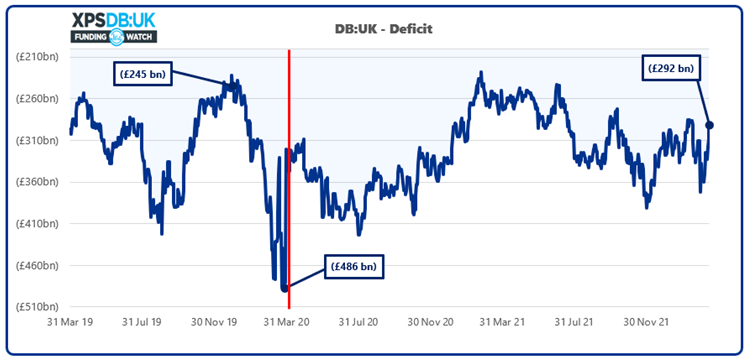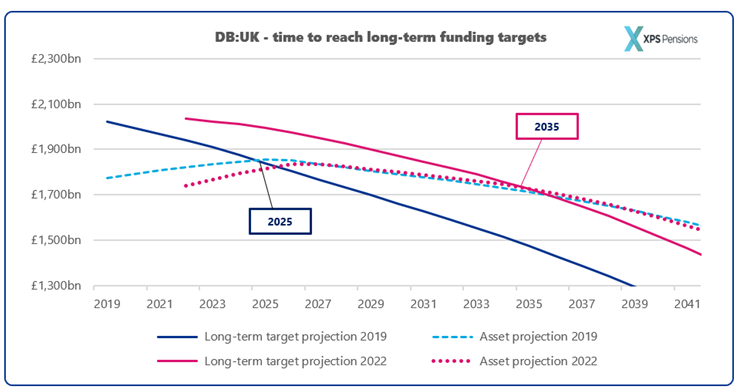The £75bn hidden pensions cost of the pandemic
The £75bn hidden pensions cost of the pandemic
23 Mar 2022
- On the two-year anniversary of the UK entering its first lockdown pension scheme deficits against long-term funding targets have reduced by £195bn, XPS Pensions Group’s DB:UK reveals.
- Whilst schemes’ positions have improved substantially since the first lockdown in March 2020, long-term deficits are still £150bn higher than what we would have expected in the absence of the pandemic. This could set back schemes’ progress in achieving their long-term funding targets by as much as 10 years**.
- If employers maintain their contributions this would reduce the term by 6 years, with schemes projected to reach their long-term targets in 2029. But this will cost sponsoring employers over £75bn.
Since the first lockdown was announced in March 2020, gilt yields and long-term inflation expectations have risen by 1.1%, reducing the value of the liabilities for most pension schemes. The strong recovery of markets in the two years since have meant that UK deficits have recovered by £195bn*. Based on assets of £1,742bn and liabilities of £2,034bn, the average funding level of UK pension schemes on a long-term target basis was 86% as of mid-March 2022.
However, recent rises in long-term inflation expectations and lower projected investment returns have set back schemes’ progress in achieving their long-term funding targets by as much as 10 years**.
In December 2019, XPS Pensions Group projected that deficits of pension schemes would reduce by £100bn over the period to March 2022 as employers paid in contributions and scheme assets delivered investment returns. However, deficits are in fact £50bn higher than they were in December 2019, meaning that schemes are £150bn worse off than projected*.
These projections assume that employers put money into the schemes until the end of existing agreed recovery plans2. Employers maintaining contributions for longer could help to reduce the term by 6 years, with the average scheme expected to reach their long-term targets in 2029. However, pursuing this strategy would cost sponsoring employers nearly £75bn.
Charlotte Jones, Senior Consultant at XPS said:
“Whilst it might be comforting to many schemes that their deficits haven’t increased markedly after a difficult two years, it’s easy to forget that the pandemic has taken its toll on their long-term funding journey. With high inflation and market uncertainty set to continue, trustees need to be carefully monitoring their funding position and investment strategy to ensure their long-term plan remains on track.”
Notes
*Figure 1 – UK DB Pension scheme deficits

**Figure 2 – Projected time to reach long-term funding targets

XPS’s DB:UK Funding Watch monitors the combined deficit and funding level of UK defined benefit (DB) pension schemes (i.e. all registrable schemes - including hybrids) on a long-term target basis using a discount rate of Gilts + 0.5%. It combines XPS’s market leading Member Analytics and the award-winning journey planning tool, Radar, enabling real time monitoring of changes and analysis of the reasons behind any movement.
Related links
- Register for events
- Join our mailing list
Register for events
We enjoy hosting a wide range of events for pension scheme trustees, corporate sponsors, independent trustees, and pensions professionals.
Join our mailing list
Keep up to date with our latest news and views including pension briefings, XPS insights, reports and event invitations.



